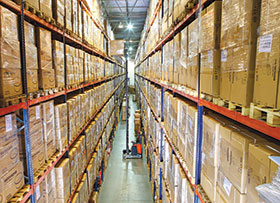

Regulations for fire protection and fire brigades focus on the health and safety of persons in buildings, and not on reducing the cost of property damages1. In consequence, property loss prevention is the domain of the insurers. Their focus is mainly on the reduction of the potential material damage.
However, for most businesses the impact of business disruption is not necessarily reflected by the amount of damage done to the property. A very small fire can have a significant impact on business operation. Electronic equipment, sensitive tools or stocks of fabrics or food will need cleaning, repair or replacement before normal business operation can resume.
Many large fire events are the result of a delay in the notification system, the improper design of fire protection systems, or the inactivation or improper operation of suppression systems. Knowing about potential fire threats and being able to detect and act upon in a timely manner will substantially reduce the financial risk involved.
Early warning is key to a timely response
Automatic detection and notification is a key element in protection. A detection system able to provide an early warning can reduce the lead-time to initiate the response. This enhanced notification would reduce the severity of the fire upon arrival of the fire department and increase the chance to control the fire before it has destroyed the building.
The objective of an early warning system is not only to issue warnings and alarms, but also to empower individuals threatened by hazards to act in sufficient time and in an appropriate manner to reduce not only the possibility of personal injury or loss of life, but also the potential damage to property and business interruption.
For the reasons stipulated above, designing to typical code requirements will not necessarily meet property protection and business continuity goals. Only performance-based designs that consider fire ignition scenarios and design for these scenarios address these goals, rather than simply meeting the code compliance or insurers’ requirements. As such, the fire alarm system becomes a vital part of an early warning system, which not only delivers warnings, but also assures a prompt response in respect to the particular nature or level of severity of the warning.
Early detection of fire
Key element of an effective early warning system is the detection of a fire in its incipient stage. When trying to detect a fire very early, the following challenges must be tackled:
• Stratification and dilution: When the fire has insufficient energy for the smoke to rise to the ceiling because it is mixed with fresh air and thus cooled to the temperature of the surrounding air and loses buoyancy, spreading out in a layer way below the detectors. Furthermore, relatively small or even incipient fires may produce little smoke which will get easily diluted and become invisible to detectors operating at regular sensitivity.
• Obstruction: High-bay storage facilities are massively obstructed spaces. Effective detection needs to be placed near the potential source of ignition. In practice, this is within the shelves and at different levels.
• Maintenance: Detectors need to be tested on a regular base by applying smoke and recording the alarm capability. Accessing these detection spots in a densely packed and fully automated warehouse at different levels is expensive due to labour costs, business interruption and equipment needed.
A reliable early warning detection system which meets the above challenges adequately is based on smoke aspiration technology. Even highly diluted smoke, invisible for the human eye, will trigger an alert. A programmable set of triggers will provide alerts at different levels of severity and allow for a progressive response. Aspirating smoke detectors are by far more reliable and faster in detecting fires than other detectors and they will perform better in the dusty and dirty environment. False alarms will almost certainly be a thing of the past, and maintenance will be far less costly.
1. Fire Detection in Warehouse Facilities, Daniel T. Gottuk, Joshua Dinaburg, Springer Verlag GmbH, Berlin, Germany, January 2012
| Tel: | +41 910 5050 |
| Email: | [email protected] |
| www: | www.securiton.com |
| Articles: | More information and articles about Securiton |

© Technews Publishing (Pty) Ltd. | All Rights Reserved.